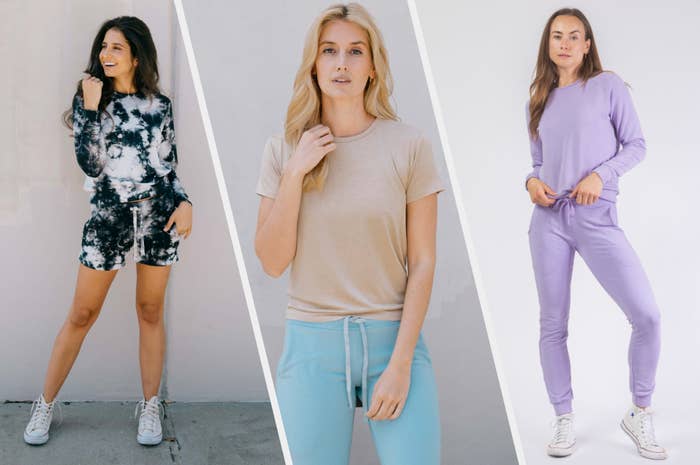Branded Clothing Maintenance Tips Based on Fabric Composition
Branded Clothing Maintenance Tips Based on Fabric Composition
Blog Article
The Significance of Lasting Clothes: Just How It Impacts the Setting and Your Closet
Sustainable apparel is increasingly recognized for its vital duty in lessening the environmental impact of the fast apparel industry. By concentrating on environmentally friendly products and honest manufacturing approaches, it addresses pressing eco-friendly problems. This change not just benefits the earth yet likewise affects consumer selections, resulting in a much more thoughtful technique to wardrobe monitoring. Recognizing these dynamics increases vital concerns concerning fashion's future and individual responsibility fit it.
The Ecological Footprint of Rapid Fashion

Benefits of Sustainable Materials
Lasting materials supply significant advantages, especially with eco-friendly material choices that lessen environmental harm. These materials additionally show longevity and durability, decreasing the demand for regular replacements. Because of this, they contribute to a much more sustainable style market and advertise liable consumer behavior.
Eco-Friendly Textile Options
While the fashion business has actually long been linked with quick trends and ecological harm, the surge of environment-friendly fabric choices offers a transformative opportunity. Lasting products such as organic cotton, hemp, and Tencel have actually gained appeal because of their reduced environmental effect. These fabrics are often created without damaging pesticides and require much less water, reducing their carbon footprint - Branded Clothing. In addition, numerous environmentally friendly textiles are naturally degradable, adding to a round economy by lessening waste. Choosing sustainable products not just supports eco responsible practices however likewise promotes much healthier ecosystems. As consumers become a lot more familiar with their purchasing power, the demand for green materials motivates brand names to introduce and take on more sustainable production techniques, eventually profiting the earth and future generations
Toughness and Long Life Benefits
Numerous consumers are significantly recognizing the toughness and durability advantages of sustainable products in their clothes options. Unlike conventional fabrics, lasting products such as organic cotton, hemp, and recycled polyester are engineered to withstand deterioration, resulting in garments that last longer. This reduced regularity of replacement not just conserves consumers money gradually however additionally reduces waste generated by quick fashion. Furthermore, sustainable clothes typically uses eco-friendly manufacturing methods that enhance textile toughness, contributing to a reduction in the overall carbon impact. By buying sturdy garments, consumers can cultivate a more lasting wardrobe while delighting in premium pieces that keep their aesthetic and functionality with time. Toughness and durability stand as key benefits of picking sustainable products.
Minimizing Waste With Lasting Practices
Minimizing waste in the fashion business can be achieved via ingenious practices such as upcycling and repurposing products. Furthermore, taking on minimal closet techniques urges consumers to focus on high quality over quantity, eventually decreasing garments usage. With each other, these techniques add significantly to an extra lasting clothes version.
Upcycling and Repurposing Materials
Upcycling and repurposing products have actually become cutting-edge strategies in the style industry, changing discarded textiles into beneficial new items. This approach not only decreases waste but additionally motivates creative thinking and individuality in garments layout. By taking old garments and materials, designers can develop one-of-a-kind pieces that reflect personal design while lowering the need for new sources. In addition, upcycling usually requires much less power and water contrasted to traditional production processes, considerably lowering the ecological footprint of style. As consumers become more knowledgeable about sustainability, the appeal of upcycled garments proceeds to rise, promoting a circular economic climate. Eventually, these practices add to a more sustainable future, where fashion prioritizes environmental health over fast production and usage.

Minimalist Closet Approaches
As individuals increasingly look for to lessen their environmental impact, embracing minimalist wardrobe strategies has acquired traction as an effective approach to lasting style. These methods highlight high quality over quantity, encouraging customers to curate a smaller collection of versatile, sturdy apparel. By concentrating on ageless pieces that can be combined and matched, people can decrease the frequency of acquisitions and eventually decrease waste.Additionally, minimalism advertises conscious intake, advising shoppers to assess the environmental and ethical effects of their options. This approach not just cultivates a much more sustainable way of living but also streamlines everyday decision-making concerning attire. As individuals embrace minimal concepts, they add to a style society that values sustainability and responsible consumerism, inevitably causing a more eco-conscious culture.
The Role of Honest Labor in Sustainable Style
While lots of customers are increasingly familiar with the ecological effects of their clothes choices, the value of ethical labor techniques in sustainable fashion can not be ignored. Ethical labor incorporates reasonable earnings, secure working problems, and regard for employees' civil liberties, forming the backbone of accountable style production. Brands that prioritize moral labor not only uplift areas but likewise established a standard for responsibility in the industry.Moreover, the assimilation of ethical methods fosters openness, enabling consumers to make enlightened choices regarding their purchases. This practice contrasts dramatically with fast fashion's exploitative labor designs, which often prioritize revenue over people. By supporting business committed to honest labor, customers add to a system that values human self-respect together with ecological sustainability. Subsequently, moral labor is not merely an add-on; it is vital to the more comprehensive mission of sustainable fashion, making sure that the mission for eco-friendliness does not come with the expenditure of human legal rights.
The Influence of Sustainable Clothing on Carbon Emissions
Lasting garments has the prospective to read the full info here greatly lower carbon discharges connected with the garment industry. Typical garment production adds significantly to greenhouse gas emissions, largely because of energy-intensive manufacturing procedures and the use of non-renewable sources. In contrast, lasting style focuses on environmentally friendly products, such as organic cotton or recycled fibers, which often call for less power to produce.Moreover, sustainable brands often tend to embrace a lot more efficient production methods, minimizing waste and reducing overall exhausts. By prioritizing longevity and ageless design, sustainable apparel motivates customers to buy much less regularly, further minimizing the carbon impact linked with overconsumption.Additionally, many sustainable brand names are committed to transparency in their supply chains, making it possible for consumers to make educated choices that align with their worths. Ultimately, shifting in find out this here the direction of sustainable garments can result in a significant decrease in carbon exhausts, adding to a healthier earth and an extra lasting future for the apparel industry.
Supporting Local Economic Situations With Sustainable Choices
The shift toward sustainable clothes not just addresses environmental concerns yet also significantly benefits neighborhood economic climates. By selecting sustainable style, customers typically sustain local craftsmens and tiny services, enhancing community strength. These ventures typically operate on a smaller scale, prioritizing craftsmanship and honest techniques over mass production.Investing in locally made lasting apparel cultivates work production and boosts financial development within areas. As consumers become much more conscious of the environmental impact of their purchases, they progressively look for items that show their values. This need urges regional makers to adopt sustainable practices, adding to a round economy.Moreover, supporting local services decreases transportation emissions, straightening with eco-conscious customer behavior. The interconnectedness of sustainable apparel and neighborhood economies emphasizes the important duty that specific options play in promoting both ecological and financial health and wellness. By fostering these neighborhood connections, communities can thrive while additionally working in the direction of a much more sustainable future.
Changing Your Wardrobe: Tips for a Sustainable Closet
As individuals look for to lower their ecological effect, transforming a wardrobe into a lasting wardrobe comes to be an important action. One efficient approach is to evaluate existing garments, keeping just products that are worn regularly which align with sustainability objectives. Prioritizing quality over amount is important; buying sturdy pieces from eco-friendly brand names can significantly decrease waste.Additionally, including used things can rejuvenate a wardrobe while minimizing environmental damages. Organizing clothes swaps with buddies or giving away extra items can better advertise sustainability.When shopping, individuals need to look for products that are organic, recycled, or eco-friendly, and prevent quick fashion sellers - Branded Clothing. Exercising mindful consumption by thoughtfully considering each purchase can contribute to a more sustainable lifestyle. web By carrying out these ideas, one can produce a closet that shows individual style while supporting environmental stewardship
Often Asked Concerns
Exactly How Can I Determine Lasting Garments Brands?
To recognize sustainable apparel brands, one ought to look into products made use of, check for accreditations like Fair Trade, and analyze the brand's openness concerning their manufacturing processes, labor practices, and ecological influence, making sure environment-friendly and honest techniques are focused on.
What Are the Expenses Connected With Sustainable Style?
The prices connected with lasting style can differ significantly. Higher manufacturing costs, ethical sourcing, and green materials typically result in increased retail rates, which might hinder some customers while appealing to eco mindful shoppers.
Can Lasting Clothes Be Stylish and elegant?
Lasting apparel can without a doubt be fashionable and trendy. Developers increasingly focus on innovative materials and ethical manufacturing methods, verifying that style and sustainability can exist together. Customers now have varied alternatives that blend visual appeals with ecological awareness.
Exactly How Does Laundering Clothes Affect Their Sustainability?
Washing garments significantly effects sustainability by consuming water and power, contributing to contamination, and causing microplastic launch. Regular cleaning can deteriorate textiles, reducing their lifespan and enhancing the demand for substitutes, ultimately worsening ecological concerns.
What Is the Life Expectancy of Lasting Clothing Compared to Quick Style?
The life-span of lasting clothing commonly exceeds that of quick fashion items, frequently long lasting a number of years due to top quality products and craftsmanship. In comparison, quick fashion garments may deteriorate rapidly, demanding more frequent replacements. Lasting apparel is progressively acknowledged for its important role in reducing the ecological impact of the quick fashion industry. While many consumers are significantly mindful of the ecological consequences of their apparel selections, the relevance of moral labor methods in sustainable style can not be overlooked. Branded Clothing. Sustainable apparel has the possible to substantially lower carbon discharges connected with the fashion sector. In contrast, sustainable style focuses on environmentally friendly materials, such as organic cotton or recycled fibers, which commonly need less energy to produce.Moreover, sustainable brand names often tend to embrace a lot more effective production methods, reducing waste and lowering total emissions. By focusing on toughness and ageless layout, sustainable clothing urges consumers to purchase less frequently, further decreasing the carbon impact connected with overconsumption.Additionally, many lasting brand names are dedicated to transparency in their supply chains, making it possible for customers to make educated selections that line up with their values
Report this page